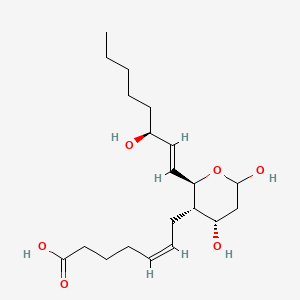Thromboxane b2
Thromboxane b2 is a lipid of Fatty Acyls (FA) class. Thromboxane b2 is associated with abnormalities such as endothelial dysfunction, Diabetes Mellitus, Non-Insulin-Dependent, Diabetes Mellitus, Ischemia and Thrombocytosis. The involved functions are known as Platelet Activation, Excretory function, Anabolism, Inflammation and mRNA Expression. Thromboxane b2 often locates in Endothelium, Hepatic and Microsomes, Liver. The associated genes with Thromboxane b2 are PTGS2 gene, prothrombin fragment 2 and CCL14 wt Allele.
Cross Reference
Introduction
To understand associated biological information of Thromboxane b2, we collected biological information of abnormalities, associated pathways, cellular/molecular locations, biological functions, related genes/proteins, lipids and common seen animal/experimental models with organized paragraphs from literatures.
What diseases are associated with Thromboxane b2?
Thromboxane b2 is suspected in endothelial dysfunction, Diabetes Mellitus, Non-Insulin-Dependent, Diabetes Mellitus, Ischemia, Thrombocytosis, Acute Coronary Syndrome and other diseases in descending order of the highest number of associated sentences.
Related references are mostly published in these journals:
| Disease | Cross reference | Weighted score | Related literature |
|---|
Possible diseases from mapped MeSH terms on references
We collected disease MeSH terms mapped to the references associated with Thromboxane b2
PubChem Associated disorders and diseases
What pathways are associated with Thromboxane b2
There are no associated biomedical information in the current reference collection.
PubChem Biomolecular Interactions and Pathways
Link to PubChem Biomolecular Interactions and PathwaysWhat cellular locations are associated with Thromboxane b2?
Visualization in cellular structure
Associated locations are in red color. Not associated locations are in black.
Related references are published most in these journals:
| Location | Cross reference | Weighted score | Related literatures |
|---|
What functions are associated with Thromboxane b2?
Related references are published most in these journals:
| Function | Cross reference | Weighted score | Related literatures |
|---|
What lipids are associated with Thromboxane b2?
There are no associated biomedical information in the current reference collection.
What genes are associated with Thromboxane b2?
Related references are published most in these journals:
| Gene | Cross reference | Weighted score | Related literatures |
|---|
What common seen animal models are associated with Thromboxane b2?
There are no associated biomedical information in the current reference collection.
NCBI Entrez Crosslinks
All references with Thromboxane b2
Download all related citations| Authors | Title | Published | Journal | PubMed Link |
|---|---|---|---|---|
| Xing X and Xia S | Injury of liver sinusoidal endothelial cells in isolated liver perfusion model for regional chemotherapy in rats. | 1998 | Chin. Med. J. | pmid:10374437 |
| Mao E et al. | [Pancreatic ischemia: a continuous injury factor in acute necrotic pancreatitis]. | 1997 | Zhonghua Wai Ke Za Zhi | pmid:10374521 |
| Ren YJ et al. | Inhibitory effects of nimodipine on platelet aggregation and thrombosis. | 1998 | Zhongguo Yao Li Xue Bao | pmid:10374642 |
| Shan CW et al. | Inhibitory effects of procainamide on rabbit platelet aggregation and thromboxane B2 production in vitro. | 1998 | Zhongguo Yao Li Xue Bao | pmid:10374644 |
| Tong H et al. | Prostaglandin endoperoxide synthase-2 abundance is increased in brain tissues of late-gestation fetal sheep in response to cerebral hypoperfusion. | 1999 May-Jun | J. Soc. Gynecol. Investig. | pmid:10376268 |
| Praticó D et al. | Iron-dependent human platelet activation and hydroxyl radical formation: involvement of protein kinase C. | 1999 | Circulation | pmid:10377074 |
| Carvalho C et al. | A rat model presenting eosinophilia in the airways, lung eosinophil activation, and pulmonary hyperreactivity. | 1999 | Exp. Lung Res. | pmid:10378102 |
| Tanaka H et al. | Leukotriene (LT)-receptor antagonist is more effective in asthmatic patients with a low baseline ratio of urinary LTE4 to 2,3-dinor-6-keto-prostaglandin (PG)F1alpha. | 1999 | Allergy | pmid:10380781 |
| Walsh SW et al. | AA-2414, an antioxidant and thromboxane receptor blocker, completely inhibits peroxide-induced vasoconstriction in the human placenta. | 1999 | J. Pharmacol. Exp. Ther. | pmid:10381779 |
| Panara MR et al. | Dose-dependent inhibition of platelet cyclooxygenase-1 and monocyte cyclooxygenase-2 by meloxicam in healthy subjects. | 1999 | J. Pharmacol. Exp. Ther. | pmid:10381787 |
| Freedman JE et al. | Deficient platelet-derived nitric oxide and enhanced hemostasis in mice lacking the NOSIII gene. | 1999 | Circ. Res. | pmid:10381894 |
| Cryer B and Feldman M | Effects of very low dose daily, long-term aspirin therapy on gastric, duodenal, and rectal prostaglandin levels and on mucosal injury in healthy humans. | 1999 | Gastroenterology | pmid:10381905 |
| Kubo K et al. | A 21-aminosteroid, U-74006F, attenuates endotoxin-induced lung injury in awake sheep. | 1999 | Respirology | pmid:10382236 |
| Williams CA et al. | The flavonoids of Tanacetum parthenium and T. vulgare and their anti-inflammatory properties. | 1999 | Phytochemistry | pmid:10382317 |
| Brown N et al. | Comparison of antiplatelet activity of microencapsulated aspirin 162.5 Mg (Caspac XL), with enteric coated aspirin 75 mg and 150 mg in patients with atherosclerosis. | 1999 | Br J Clin Pharmacol | pmid:10383561 |
| Itasaka H et al. | The mechanism of hepatic graft protection against reperfusion injury by prostaglandin E1. | 1999 | Surg. Today | pmid:10385367 |
| Maitra SR et al. | Alterations in hepatic gluconeogenesis, prostanoid, and intracellular calcium during sepsis. | 1999 | Acad Emerg Med | pmid:10386675 |
| Bowers W et al. | Artificial human skin: cytokine, prostaglandin, Hsp70 and histological responses to heat exposure. | 1999 | J. Dermatol. Sci. | pmid:10397388 |
| Peredo HA et al. | Time-course of the alterations in prostanoid production and in contractile responses of mesenteric beds isolated from streptozotocin diabetic rats. | 1999 | Prostaglandins Leukot. Essent. Fatty Acids | pmid:10397409 |
| Saareks V et al. | Nicotinic acid and pyridoxine modulate arachidonic acid metabolism in vitro and ex vivo in man. | 1999 | Pharmacol. Toxicol. | pmid:10401729 |
